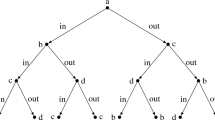Abstract
We show the inability of any pure strategy imitation rule for leading a decision maker towards optimality for given and fixed population behaviour. The intuition is that a pure strategy state space is too small to deal with a large variety of environments. This result helps to understand the optimality result obtained by Schlag (1998), where the population behaviour is let to evolve over time. The intuition is that the group composition provides an additional state space in which information about the environment can be accumulated.
Similar content being viewed by others
References
Binmore, K. (1987). “Modeling Rational Players, I andII.” Economics and Philosophy 3, 179–214.
Binmore, K. (1987). “Modeling Rational Players, I andII.” Economics and Philosophy 4, 9–55.
Börgers, T. and R. Sarin. (1997). “LearningThrough Reinforcement and Replicator Dynamics.” Journal of EconomicTheory 77, 1–14.
Börgers, T., A.J. Morales, and R. Sarin.(1998). “Simple Behaviour Rules Which Lead To Expected Payoff MaximisingChoices.” mimeo UCL.
Cross, J. (1973). “A Stochastic Learning Model ofEconomic behaviour.” Quarterly Journal of Economics 87, 239–266.
Erev, I., and A. Roth. (1998). “Predicting HowPeople Play Games: Reinforcement Learning in Experimental Games with Unique,Mixed Strategy Equilibria.” American Economic Review 88, 848–881.
Fudenberg, D. and D. Levine. (1998). The Theoryof Learning in Games. Cambridge: MIT Press.
Grimmett, G. and D. Stirzaker. (1992). Probability and Random Processes (2nd edition). Oxford: Clarendon Press.
Hopkins, Ed. (2002). “Two Competing Models of How PeopleLearn in Games.” Econometrica 70, 2141–2166.
Hopkins, Ed and M. Posch. (2002). “Attainability of Boundary Points under Reinforcement Learning.” forthcomingin Games and Economic Behaviour.
Karandikar, R., D. Mookherjee, D. Ray, and F. Vega-Redondo. (1998). “Evolving Aspirations and Cooperation.” Journal of Economic Theory 80, 292–331.
Roth, A. and I. Erev. (1995). “Learning inExtensive-Form Games: Experimental Data and Simple Dynamic Models in theIntermediate Term.” Games and Economic Behavior 8, 164–212.
Rustichini, A. (1999). “Optimal Properties ofStimulus-Response Learning Models.” Games and Economic Behavior 29, 244–273.
Schlag, K. (1998). “Why Imitate, and if so, How? ABoundedly Rational Approach to Multi-armed Bandits.” Journalof Economic Theory 78, 130–156.
Author information
Authors and Affiliations
Corresponding author
Rights and permissions
About this article
Cite this article
Morales, A.J. On the Role of the Group Composition for Achieving Optimality. Ann Oper Res 137, 387–397 (2005). https://doi.org/10.1007/s10479-005-2268-1
Issue Date:
DOI: https://doi.org/10.1007/s10479-005-2268-1




